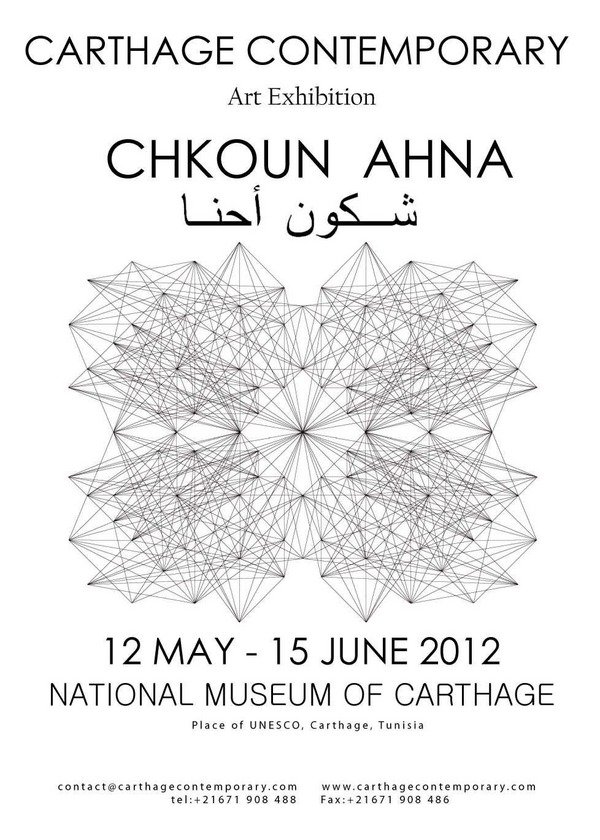Chkoun Ahna
dal 10/5/2012 al 14/6/2012
Segnalato da
Ahmed Mater
Ahmet Ogut
Ali Tnani
Amina Menia
Ayse Erkmen
Boris Kajmak
Fakhri El Ghezal
Felix Fernandez
Hala Elkoussy
Hrair Sarkissian
Ismail Bahri
Kader Attia
Lara Favaretto
Maha Malluh
Mouna Karray
Mustapha Akrim
Nadia Kaabi-Linke
Nicene Kossentini
Nida Sinnokrot
Pascal Hachem
Saadane Afif
Sirine Fattouh
Taysir Batniji
Timo Nasseri
Yousef Moscatello
Ziad Antar
Zineb Sedira
Khadija Hamdi
Timo Kaabi-Linke
10/5/2012
Chkoun Ahna
Carthage National Museum, Carthage
The international group exhibition, main part of the first edition of Carthage Contemporary, is surrounded by Phoenician and Roman ruins, Byzantine and French architecture. It is followed by several collateral events and programs, like off-space exhibitions at the Centre National d'Art Vivant and the B'chira Art Centre, artist talks, and a gallery weekend in the northern suburbs of Tunis. TheTunisian dialect expression 'chkoun ahna' means both 'about us' and 'who are we?', able to be phrased as a statement or a question.

The First International Contemporary Art Exhibition at the National Museum of Carthage
The international group exhibition CHKOUN AHNA is
the main part of the first edition of Carthage Contemporary. The exhibition is sheltered in the east wing of
the archaeological museum of Carthage, where contemporary art encounters ancient relics. It is followed
by several collateral events and programs, like
off-space exhibitions at the Centre National d’Art
Vivant and the B’chira Art Centre, artist talks, and a
gallery weekend in the northern suburbs of Tunis.
The National Museum is located on the hill of Birsa
where the exhibition CHKOUN AHNA is surrounded
by Phoenician and Roman ruins, Byzantine and French
architecture. The excavated past reveals that Tunisian
history has always been characterized by diversity and
cultural exchange. In this sense, the curators Khadija
Hamdi and Timo Kaabi-Linke have invited artists from
countries that are historically connected with Tunisia
to install new and recent works that relate to the place
and its past.
The expression chkoun ahna is Tunisian dialect written
in Roman letters. It means both “about us” and “who
are we?”, able to be phrased as a statement or a question.
Many things changed after spring 2011. Today, Tunisian society seems to culminate in a hunt for identity.
The international exhibition will slow down this
endeavour and offer a unhurried view on the current
state of emergency. There are at least two hypothetical
reasons to do so: First of all, even the state of emergency is part of our modern life, and history shows that
any catastrophe is absorbed into the everyday in the long run. Secondly, all efforts to purify Tunisian heritage and sort out a homogeneous cultural identity are
doomed to fail. Tunisian history was and still is a cross-cultural joint venture. There were Capsian and Berber
civilizations, Phoenicians, Romans, Vandals, Arabs,
Ottomans and the French. Discussion of Tunisian
culture implies all these hybrid influences.
For this reason, the exhibition will raise the question
CHKOUN AHNA as a statement powered by the media
of contemporary art, such as installations, video and
photo-projections, photographs, performance, interventions, and drawings. Similar to the cross-cultural
history of Tunisia, the invited artists hail from countries
that have left historical traces in Carthage, in the more
or less chronological order of Algeria, Lebanon, Italy,
Germany, Iran, Saudi Arabia, Morocco, Spain, Turkey,
and France.
The Carthage National Museum usually display
archaeological findings and is one of the two main
archaeological museums in Tunisia. It is sited at the hill
of Byrsa in the center of the city of Carthage and was
founded in 1875. Along with the Bardo Museum it is
one of the country's most extensive museums. The
singularity of this place is that the museum building is
surrounded by archaeological excavations revealing
the Punic and Roman history of this place.
ARTIST:
Ahmed Mater
Ahmet Ogut
Ali Tnani
Amina Menia
Ayse Erkmen
Boris Kajmak
Fakhri El Ghezal
Felix Fernandez
Hala Elkoussy
Hrair Sarkissian
Ismail Bahri
Kader Attia
Lara Favaretto
Maha Malluh
Mouna Karray
Mustapha Akrim
Nadia Kaabi-Linke
Nicene Kossentini
Nida Sinnokrot
Pascal Hachem
Saadane Afif
Sirine Fattouh
Taysir Batniji
Timo Nasseri
Yousef Moscatello
Ziad Antar
Zineb Sedira
Further Inquiries:
General inquiries: CarthageContemporary
contact@carthagecontemporary.com
tel +216 71 908 488
fax+216 71 908 486
Aziza Amri (coordination and press)
aziza@carthagecontemporary.com
Khadija Hamdi (curator)
khadija@carthagecontemporary.com
Timo Kaabi-Linke (curator)
timo@carthagecontemporary.com
Press Conference: May 11, 2012 at 4pm
Opening: May 11, 2012 at 5pm
Artist's talk: May 11, 2012 from 2pm to 4pm at acropolium de Carthage
The National Museum of Carthage - UNESCO Heritage
Center Hill of Byrsa - Carthage, Tunisi



